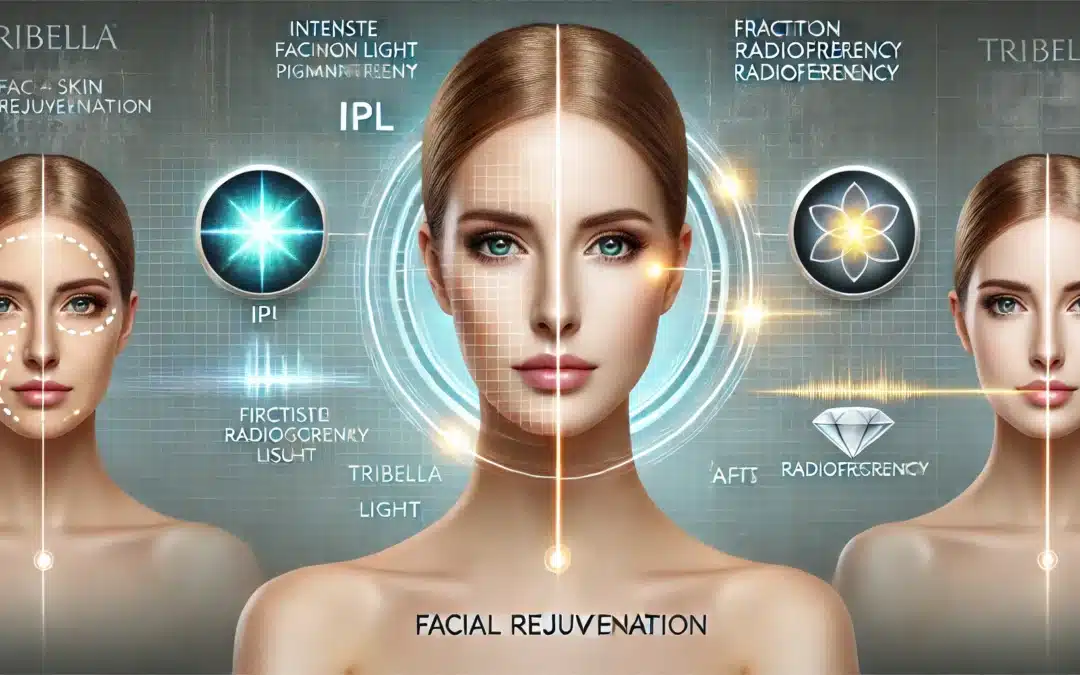
by wallacemcd | Jun 19, 2024 | Uncategorized
TriBella Facial Rejuvenation Benefits :
The Ultimate Non-Surgical Aesthetic Treatment
Key Components of TriBella Facial Rejuvenation
TriBella combines three cutting-edge technologies in a single treatment session to deliver outstanding results:
Photofacial (Intense Pulsed Light – IPL):
This treatment uses light energy to tackle pigmentation issues such as age spots, sun damage, and vascular lesions. By reducing discolouration and redness, IPL significantly improves skin tone. Whether you’re dealing with hyperpigmentation, freckles, or broken capillaries, IPL offers a versatile solution for uneven skin tone.
Skin Resurfacing (Fractional Radiofrequency):
This technology utilises radiofrequency energy to create micro-wounds in the skin, stimulating the body’s natural healing process. This boosts collagen production, which helps improve skin texture, reduce fine lines and wrinkles, and promote overall skin rejuvenation. The controlled damage prompts a regenerative response, leading to smoother, more youthful-looking skin.
Skin Tightening (DiamondPolar Radiofrequency with Pulsed Electro Magnetic Fields):
This component combines radiofrequency and pulsed electromagnetic fields to heat the deeper layers of the skin, encouraging collagen and elastin production. The result is firmer, tighter skin with improved elasticity, particularly beneficial for areas prone to sagging like the jawline, neck, and around the eyes.
Benefits of TriBella Facial Rejuvenation
TriBella’s multifaceted benefits make it a top choice for those seeking effective, non-surgical facial rejuvenation solutions:
- Comprehensive Treatment: By merging three technologies, TriBella tackles multiple skin concerns in one session. This holistic approach ensures that various aspects of skin aging are addressed simultaneously, leading to more comprehensive and noticeable results.
- Non-Surgical: TriBella is a non-invasive procedure, eliminating the need for surgery or significant downtime. Clients can enjoy facial rejuvenation benefits without the risks and recovery time associated with surgical options.
- Minimal Discomfort: Treatments are designed to be comfortable, with minimal pain or discomfort. Most clients report a slight warming sensation during the procedure, making it a tolerable experience.
- Quick Sessions: Each TriBella session typically lasts around 60-90 minutes, making it convenient for individuals with busy schedules who desire effective results without spending hours in a clinic.
- Long-Lasting Results: With a series of treatments, clients can achieve significant improvements in skin tone, texture, and tightness, with results that continue to improve over time. The stimulated collagen production ensures that TriBella’s benefits extend well beyond the treatment sessions.
Ideal Candidates for TriBella Facial Rejuvenation
TriBella is perfect for those aiming to address various skin issues without surgical intervention. It can effectively treat:
- Hyperpigmentation and sun damage: If you struggle with dark spots, sunspots, and other pigmentation issues, TriBella’s IPL component specifically targets melanin, helping fade these spots and create a more even skin tone.
- Fine lines and wrinkles: The skin resurfacing and tightening components work together to reduce the appearance of fine lines and wrinkles, offering a smoother, more youthful look.
- Uneven skin texture: Individuals with rough or uneven skin texture can benefit from the resurfacing technology, which promotes new skin cell growth and smoother skin.
- Skin laxity and sagging: The skin tightening component addresses sagging skin, particularly around the jawline, neck, and cheeks, by stimulating collagen and elastin production.
- Redness and vascular lesions: For those with conditions like rosacea or visible blood vessels, the IPL treatment helps reduce redness and minimise the appearance of vascular lesions.
Post-Treatment Care for TriBella Facial Rejuvenation
After a TriBella session, clients might experience mild redness and swelling, typically resolving within a few hours to days. Proper post-treatment care is crucial to maximise benefits and ensure a smooth recovery. Here are some tips:
- Avoid Sun Exposure: Protect your skin from sun exposure after a TriBella treatment. Use a broad-spectrum sunscreen with at least SPF 30 and wear a wide-brimmed hat when outdoors.
- Use Gentle Skincare Products: Post-treatment, your skin may be more sensitive. Opt for gentle, hydrating skincare products that do not contain harsh chemicals or exfoliants. Look for products with soothing ingredients like aloe vera and chamomile.
- Stay Hydrated: Drinking plenty of water helps keep your skin hydrated and supports the healing process. Proper hydration also enhances overall skin health and appearance.
- Avoid Hot Water: Refrain from using hot water on the treated area for a few days. Use lukewarm water when cleansing your face to avoid irritating the skin.
- Follow Up Treatments: Depending on your initial skin condition and desired results, multiple TriBella sessions may be recommended. Adhere to the treatment schedule advised by your aesthetician to achieve the best outcomes.
Real-Life Results and Client Testimonials
Many clients have reported significant improvements in their skin’s appearance after undergoing TriBella Facial Rejuvenation. Here are some real-life testimonials:
Sarah, 45: “After just three TriBella sessions, my skin looks and feels amazing. The fine lines around my eyes and mouth have diminished, and my skin tone is much more even. I love the compliments I receive about my youthful appearance!”
James, 52: “I was sceptical at first, but TriBella has really made a difference. The sun damage and age spots on my face are barely visible now, and my skin feels firmer and smoother. It’s definitely worth it.”
Emily, 38: “TriBella has given me back my confidence. My skin texture has improved dramatically, and the redness from my rosacea is much less noticeable. The best part is that it’s a non-invasive treatment with no downtime.”
Why Choose TriBella Facial Rejuvenation?
TriBella Facial Rejuvenation stands out in the competitive non-surgical treatment market for several compelling reasons:
- Multi-Technology Approach: By combining IPL, fractional radiofrequency, and skin tightening technologies, TriBella offers a comprehensive solution that addresses a wide range of skin concerns.
- Customisable Treatment: Each TriBella session can be tailored to your specific needs, ensuring personalised care and optimal results.
- Proven Effectiveness: Clinical studies and client testimonials consistently highlight the effectiveness of TriBella in improving skin tone, texture, and tightness.
- Safe and Comfortable: TriBella treatments are designed to be safe and comfortable, with minimal risk of side effects and no need for anaesthesia.
In Summary
TriBella Facial Rejuvenation is a versatile and effective treatment for individuals looking to rejuvenate their skin and address a range of aging-related concerns. By combining photofacial, skin resurfacing, and skin tightening technologies, it offers a comprehensive approach to achieving a youthful, radiant complexion. With minimal discomfort and downtime, TriBella is an excellent choice for those seeking significant skin improvements without invasive procedures. Whether you’re dealing with hyperpigmentation, fine lines, uneven texture, or sagging skin, TriBella can help you achieve your aesthetic goals and boost your confidence.
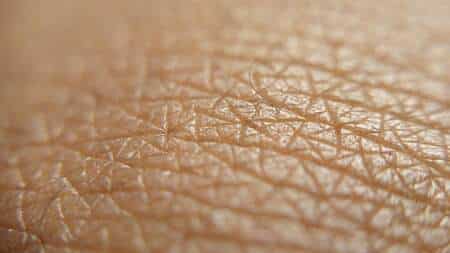
by Sue Carroll | Apr 2, 2024 | Uncategorized
Enzyme Exfoliation for the Winter Skin
All skin types can benefit from enzyme exfoliation during the cooler months of winter, where hot showers and heaters create superficial dryness. Enzymes are a naturally occurring solution for this challenge by digesting and dissolving dead, dry skin cells, revealing healthy, radiant skin.
Enzymes are primarily proteins that are necessary for life. In the body and cells their role ranges from digestion to increasing metabolism. They speed up the rate of most chemical reactions that take place in the cells, catalyzing most cellular functions.
When applied topically, enzymes are proteolytic, meaning they digest the cells of the stratum corneum – the first layer of the skin. Enzymes break down the old cells that congest the pores and will then prevent the penetration of topical serums, which in turn hinders overall skin functioning. Removing the dead skin cells, allows the skin to regenerate more quickly, assisting with skin concerns such as premature aging and acne. Other benefits when using enzymes include their ability to increase skin elasticity and hydration by maintaining natural moisture levels in the skin. Enzymes speed up cellular functioning and fight against oxidation and free radical damage, protecting skin from environmental damage.
In the treatment room enzymes and acids can be used separately or mixed, each providing a powerful result. Enzymes in general are less exfoliating than acids like glycolic, salicylic, mandelic or lactic. Therefore, they are more appropriate for sensitive, medically compromised, reactive or thin skin. Introducing enzymes in skin treatments when you are pregnant or breastfeeding is particularly useful to still allow an effective method of exfoliation.
Enzymes:
Mostly sourced from vegetables and fruit such as pumpkin, (the most exfoliating enzyme) pineapple (bromelain enzyme), papaya (papain enzyme), and apples
A gentle exfoliation method but this can be dependent on the pH
Exfoliates the stratum corneum
Less likely to irritate the skin
Function at a wider pH range
Digest dead skin cells
Come in the form of either a gommage, gel, cream, liquid or powder
Acids:
- Mostly sourced from milk, sugar and plant-based products
- Deeper exfoliation method with progressive, mid-depth and deep peeling levels
- Can be an aggressive method of exfoliation
- Are both pH and % dependent on the level of exfoliation
- Dissolve dead skin cells
Enzymes can be more efficiently utilised in the treatment room when:
The cleanser being used is chosen wisely. A creamy cleanser will limit the exfoliation intensity compared to a foamy or gel-based cleanser.
A pre-peel solution will strip the skin of lipids and therefore facilitate a more aggressive exfoliation
The use of heat and moisture with a steamer or hot towel will amplify the enzyme activity.
Enzymes can be added to many treatments in the clinic room to increase their efficacy. They can be blended with antioxidants, pure vitamins and hyaluronic acid which will increase the support, hydration and vital nutrients of the skin. Some of the treatment modalities which will benefit from the addition of enzymes are:
*Microdermabrasion results using suction and super fine crystals to exfoliate the skin can be amplified when using enzyme exfoliation before the treatment
*JetPeel treatments utilise a medical-grade saline solution instead of microcrystals from the microdermabrasion. The supersonic jet of saline droplets from the JetPeel is amplified when an enzyme solution is used before this step. This has the added benefit of improving the circulation and hydration of the skin
*Ultrasonic skin exfoliating utilises sound waves and vibrations that penetrate through the upper layers of the skin. The Ultrasonic treatment improves the texture, tone and circulation of the skin. The benefits of the Ultrasonic device are amplified when an enzyme exfoliation is used before the treatment.
Enzymes are not new in the aesthetic arena but are worth consideration when wanting healthy, hydrated and radiant skin.
Renew & Revive Skin with a Peel
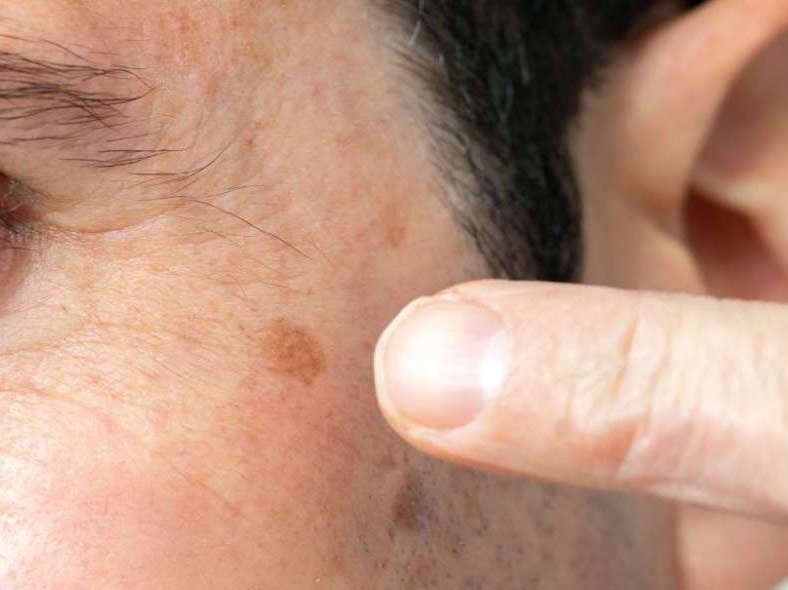
by wallacemcd | Apr 2, 2024 | Uncategorized
Brown Skin Spots On The Face And The Sun
We all desire a clear and consistent skin tone. However, lingering hyperpigmentation is a constant barrier to achieving this. It impacts every skin type at every stage of our lives, especially when sun exposure, heat and prolonged UV damage are factors. The pleasing news is that with the proper homecare regime and in-clinic treatments, the brown spots can be reduced or removed completely. This will be a consistent programme including prevention and treatment.
Hyperpigmentation refers to areas of the skin with an abnormal appearance of pigment, resulting in darker areas of the skin compared to the rest of the complexion. There are 3 main types of hyperpigmentation: epidermal (surface is light brown and not quite as dense), dermal (skin is ashen-gray and a deep brown and appears more solid), and then a mixture (both of the above levels and is usually dark brown).
There are many triggers creating pigmentation (dyschromias) changes, as well as varying depths of damage to the skin. These types of changes in the skin may occur when melanocytes (colour-producing cells) are either over-stimulated resulting in hyperpigmentation, or they may be destroyed, resulting in hypopigmentation. The colour changes may also be an uneven pigmentation from procedures, picking or scratching. Melasma is denoted by more dense larger patches and is normally created with hormonal imbalance with estrogen and progesterone. Other causes may include birth control pills, HRT, PIH (post-inflammatory hyperpigmentation), long-term sun exposure, razor bumps, heat, humidity, severe sunburn, eczema, chemical irritations, rashes, abrasive scrubs, medications, chicken pox, insect bites, surgical procedures, thyroid and adrenal disorders.
One thing to keep in mind with most types of hyperpigmentation is our melanocytes are there for a reason, which is to protect the cell initially. We need this in order to help fight against the impact of the UV rays. After this protection process has taken place, the skin is now left with underlying damage which is seen in the form of pigmentation.
The 2 main factors stimulating hyperpigmentation are UV exposure and heat. Wearing an SPF of 30+ each day will assist with this protection. The best sunscreens for hyperpigmentation are typically all-mineral formulas. Chemical SPFs neutralize the UVA and UVB rays, while the mineral SPFs, create a barrier on top of the skin, blocking these factors and protecting it from infrared damage. A huge reminder, even when you wear your hat, sun protection and sunglasses and your face is covered, tanning on other parts of your body can still stimulate the melanocytes.
Hydroquinone is a well-known ingredient to treat hyperpigmentation. It is banned in many countries as it has been linked to possibly being carcinogenic. Our skin is very smart and may develop a resistance, or immunity to it, resulting in a very dark hyperpigmentation, which usually takes longer to reduce.
Other proven ingredients for use in both homecare and clinical treatments include the enzyme papain (from the papaya), and bakuchiol (a retinol alternative supporting the skin’s cellular renewal. When applied topically it encourages sloughing of overly pigmented cells, leaving skin looking renewed and more even), mandelic acid (a water-soluble exfoliating alpha hydroxy acid made from bitter almonds and is generally tolerated well by most skin types with its larger molecular size and therefore slowing the absorption resulting in less irritation to the skin), tranexamic acid (will even out hyperpigmentation when melanin density is connected to sun damage. It is also safe to use through pregnancy), pyruvic acid ( derived from the hibiscus and is both oil and water soluble and has the capacity to brighten the faster by encouraging the rapid cell regeneration), and niacinamide (a vitamin B3 product impedes the production of melanin as it is happening).
Some of the in-clinic treatments available include IPL, Fractional laser, Tixel, Q Switch Yag and herbal and chemical peels.
Protect the skin you are in, it is yours for a lifetime. Regardless of hyperpigmentation’s cause and its associated uneven tone and dark spots, it is essential in Australia to treat and prevent it on a regular basis. It is not a seasonal call to action, but instead a year-round commitment.
Age Spots, Sun Spots, and Liver Spots
Sun spots, known as solar lentigines, liver spots, or age spots, are common dark brown facial marks caused by sun exposure. These are mostly benign but can develop into melanoma, necessitating vigilant monitoring.
Treatment and Prevention of Age Spots Preventing further sun spots is essential, achievable through rigorous sun protection. Treatments vary from over-the-counter creams to professional procedures like chemical peels and cryotherapy, which target melanin-producing cells efficiently.
Seborrheic Keratosis Typically manifesting as dark, rough, raised bumps, seborrheic keratosis becomes more prevalent with age. While treatment is often unnecessary, options like cryotherapy can enhance appearance.
Moles Moles may vary widely and are often checked for signs of skin cancer. Regular dermatological checks are critical.
Postinflammatory Hyperpigmentation This condition stems from skin inflammation and can lead to increased pigment production. Options like laser therapy and chemical peels are beneficial for managing this hyperpigmentation.
Melanoma Early detection of melanoma involves recognising irregularities in moles or spots, guided by the ABCDE rule: Asymmetry, Border irregularity, Colour variation, Diameter over 6mm, and Evolving characteristics. Regular skin checks and consultations are recommended for effective management.

by wallacemcd | Jan 17, 2024 | Uncategorized
Look into the Crystal Ball for 2024
The aesthetic profession is in constant flux, always evolving with the latest trends and technologies in health, wellness, and self-improvement. 2024 is no exception, bringing forward innovations that help us look and feel our best, inside and out.
Cold Plunge Therapy and Breathwork
Health clubs, fitness centres, and wellness retreats are helping individuals recover muscles through cold plunge treatments and breathwork practices. Cold water therapy, such as ice baths, has been found to boost circulation, enhance resilience, and reduce inflammation. When combined with breathwork, which focuses on mental and emotional health, these treatments provide a balanced approach to overall well-being.
The Return of the 90s Skinny Brow
The iconic skinny brows of the ’90s are back in vogue, with many top celebrities and beauty influencers championing this look. It’s worth noting the importance of maintaining healthy brow grooming to avoid the irreversible damage seen in the past.
Time-Efficient Skin Treatments
Busy clients are increasingly seeking out efficient, quick, yet still relaxing skincare treatments. Combining high-tech and high-touch approaches, treatments like HIFU GLOW, China Doll facials, Hollywood Red Carpet Facial, Tixel Infusion, and JetPeel offer quick yet relaxing results, catering to the needs of time-poor clients.
Mind-Body Beauty
The future of holistic wellness is mind-body beauty, intertwining mental, emotional, and physical health. This holistic approach acknowledges that overall wellness cannot be segmented, and achieving true health means nurturing both the mind and body in unison.
Pre-Rejuvenation Treatments
Pre-rejuvenation therapies are becoming immensely popular among younger demographics. These proactive measures help maintain skin laxity, even out skin tone, and reduce textural changes before signs of aging become visible. This trend is all about maintaining a flawless complexion from an early age.
Advanced Fillers
Fillers have come a long way, with hyaluronic acid-based options offering more tailored results. These minimally invasive procedures can restore volume and enhance facial features without the unnatural look often associated with fillers. New techniques, such as injecting fine hyaluronic acid into lip lines, help reduce “barcodes” and achieve a more youthful appearance.
Mushroom-Based Skincare
Mushrooms, long used in Traditional Chinese Medicine (TCM), are being reintroduced in modern skincare for their well-documented benefits. Known for their ability to boost collagen production, brighten, hydrate, and provide anti-inflammatory and antioxidant benefits, mushroom-based ingredients are being revamped and reintroduced in modern skincare formulations.
Embracing Natural Beauty
There’s a growing desire to let natural skin shine through, with makeup being used to enhance rather than conceal. The rise of skin hybrids, combining skincare benefits with a hint of colour, exemplifies this trend. Products like BB and CC creams are evolving to provide nutrients and save time, although they should be reserved for daytime use.
AI in Aesthetics
Artificial Intelligence applications are now scanning skin and providing personalised homecare advice, revolutionizing the aesthetic industry. AI-powered apps can now scan the skin and offer personalised homecare recommendations, making it easier for individuals to maintain their beauty regimens.
Healthy Aging
The concept of healthy aging is shifting focus from merely looking young to maintaining a healthy mind, body, and spirit. In 2024, the emphasis is on holistic wellness, ensuring that all aspects of health are nurtured to achieve a balanced and vibrant life.
In conclusion, 2024 promises to be an exciting year for the aesthetic profession, with trends and innovations that enhance beauty and promote overall wellness. From advanced treatments and holistic approaches to the integration of AI, the future of aesthetics is bright and full of potential.
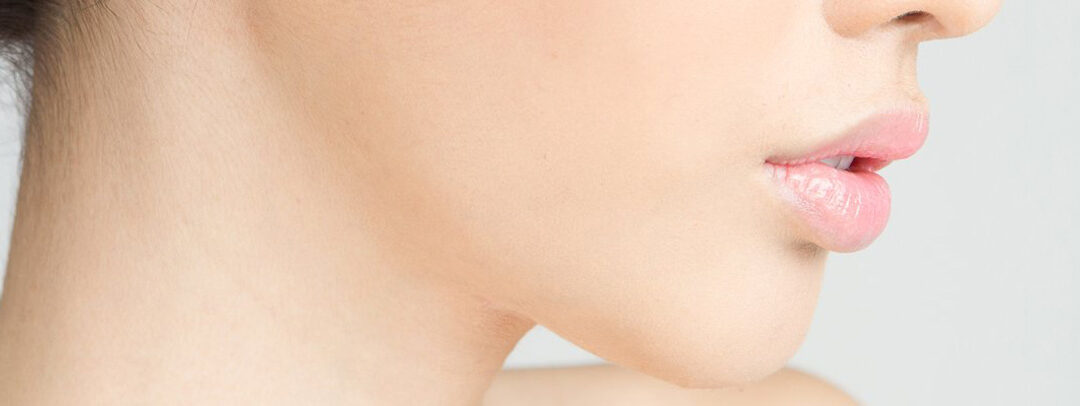
by Sue Carroll | Sep 3, 2023 | Uncategorized
Colour Correction, Skin Firming, Refinement and Radiance. What Treatment Do I Choose?
Texture, tone and colour all play a huge role in defining the appearance of healthy skin. There are many treatments available to improve the texture and complexion of your skin by reducing hyperpigmentation, and fine lines, clearing acne, improving pore size, reducing scarring and simply brightening the skin. But where to start, what to have and what to combine it all with, for the best possible result.
RF Skin Needling is a revolutionary skin tightening and firming treatment, which utilizes a combination of percutaneous needling and radio frequency to induce the tightening of elastin fibres and induce collagen production. A set of tiny needles creates controlled micro-injuries on the skin’s surface. These tiny needles also deliver radiofrequency energy to the deeper layers of the skin, promoting collagen production to firm the skin. By incorporating both the radio frequency and the use of the microneedles, the end result is a firming from the RF and a refinement of the skin texture. This treatment is also beneficial when treating stretch marks and scarring. If the skin is in a less than optimal condition it is a great choice to start with 2-3 skin needling treatments spaced about 7 days apart and then embark on the RF needling treatment which can be performed every month for 2-3 treatments with very minimal downtime.
Surface rejuvenation and toning with the Q switch laser is a gentle and non-invasive treatment that works by stimulating the deeper layers of the skin. A very short delivery system gently heats the skin, is able to shatter pigment, stimulate collagen production and assist with skin refinement all without downtime. The Q switch laser toning system is good for all skin types, particularly those who suffer from acne, blocked or enlarged pores, dull skin, pigmentation and simply those who wish to step up from their facial peels and treatments. The Q switch laser treatment may be added to a fractional laser treatment for a boost in results. It may also be used in the China Doll or Hollywood skin treatment for that special occasion.
Over time and then added stress in our lives, the underlying changes to the skin result in fine wrinkles, lines and sagging skin. HIFU is a treatment that works to lift and tighten the skin, and at the same time reduce fine lines. HIFU works by delivering ultrasound energy non-invasively to heat the skin tissue at numerous depths, from 1.5mm and up to 4.5mm for the face and up to 13mm for the body. This will trigger a natural regenerative reaction that promotes the development of new collagen and contracts the fibres for the firming effect. After the HIFU treatment, you can return to work the next day, with no visible downtime, occasionally a feeling of slight bruising may last for 2 weeks due to the depths the ultrasound has penetrated. It must be remembered nothing will replace a facelift but often when postponing this procedure, this might just be the next best thing when combined with IPL for colour correction, RF Needling for skin refinement and a little injectable here and there.
Fractional laser delivers multiple, microscopic columns of light energy into your skin to emulate micro-wounds which will in turn stimulate your skin’s natural healing and rejuvenation. Fractional laser is an effective treatment for pigmentation, fine lines created by the sun, scarring and general skin refinement. This treatment has a few days of minimal downtime and can be repeated every 4-6 until the desired results are achieved.
An old favourite and a great treatment to start with before all treatments is the IPL -Intense Pulsed Light. IPL uses multiple wavelengths and will treat both capillaries and pigmentation in the same treatment. Darkening of pigment is seen immediately post-treatment and can last 7-10 days and will then be sloughed off.
It is so easy to restore your confidence and natural beauty when you are guided by a professional aesthetician. Working with the inside and the outside, real beauty is much deeper and longer lasting and will radiate to the world. When you are not sure of what treatment is best for you, instead of guessing, simply book a consultation with your aesthetician and be guided by their expertise.
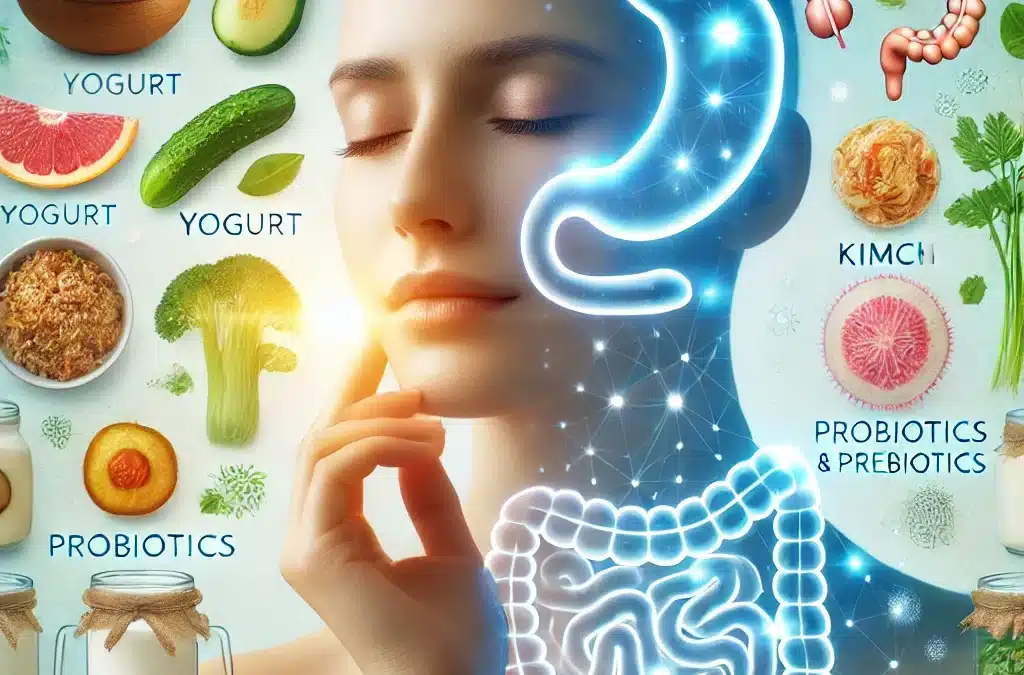
by Sue Carroll | Jan 1, 2023 | Uncategorized
Trust Your Gut When it Comes to Your Skin
In order for your skin to look good, it is dependent upon how you treat it from the outside and the inside. You may have heard the term gut-skin axis. Our skin is like a window to our gut, if you are suffering constipation, diarrhea, bloating or gas there is a good chance you may be experiencing facial dryness, rosacea, acne or other inflammatory skin conditions. These are some of the symptoms of poor gut health and research has shown by addressing your gut health through diet, lifestyle and supplemental support you will be glowing from the inside out.
The gut is often referred to as our second brain and has a definite link with both our well-being and skin health. While our gut is certainly not one of the most glamorous organs in our body, 1-2 kgs of microbes that live there, form each person’s unique microbiome. Our brain isn’t the only organ in control of our emotions – 95% of serotonin, the body’s happy hormone is created in the gut and also has a profound effect on our physical, mental and emotional balance. Without good gut health, we are unlikely to be absorbing efficiently the nutrients we are taking in and therefore our skin will reflect our poor health. Our gut bacteria are important to assist with producing micro-nutrients like vitamins and antioxidants from the food we ingest. Our gut will also support the breakdown of macro nutrients such as carbohydrates, proteins and fats to ease digestion and keep our colon healthy.
Some of the signs of poor gut health might be food allergies, poor memory, autoimmune disease, diabetes, anxiety, depression, hormonal imbalances, low energy, dark circles under the eyes, frequent infections, mood swings, interrupted sleep, acne, dry skin, rosacea, eczema, psoriasis and dermatitis.
When the regulatory balance in the gut is evident this in turn creates an inflammatory response which will often show up in the skin with one or more of the above conditions. Remember our skin is our largest organ and is often the outside mirror for what is happening on the inside. If the skin is inflamed, it usually means our inside is screaming out to us for help on the inside. The gut microbiome and the skin are intrinsically connected, offering a defence against pathogens in the environment. This gut-skin axis has been linked to many inflammatory skin disorders. When there is dis-ease within the gut there is often inflammation in the skin.
So how can you keep your gut healthy? A good rule of thumb is to eat a wide variety of nutritious whole foods from all food groups, which will also contain a lot of plant foods that are beneficial for your gut bacteria. An easy way to think of good food compared to that which may not be so healthy is to limit drastically food which comes in a packet. One of the best kinds of food for good gut health is that which is fermented such as yoghurt, kimchi and apple cider vinegar as they are overflowing with good probiotics. These support our immune defences and can also help to break down foods we can find hard to digest. The second way to support good gut health is through prebiotics found in foods like barley, beans, garlic, onions, cabbage, asparagus and legumes. A good nutritionist or naturopath may assist with your gut health.
While you are working on your inside with a good health professional, the external inflammation can be reduced with in Clinic treatments such as the Jet Peel Exfoliation and Infusion. Often the skin will be experiencing dryness, flaking, acne and inflammation and when these are reduced through gentle but effective, cooling exfoliation techniques, hydrating and calming serums can be absorbed much more effectively assisting with topical results.
By making simple changes to your diet and correcting any underlying imbalances in your gut your skin will thank you for it with a radiant complexion.






